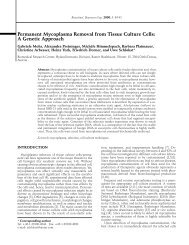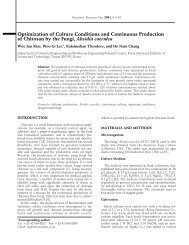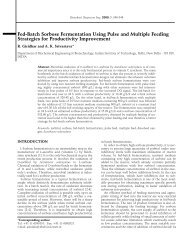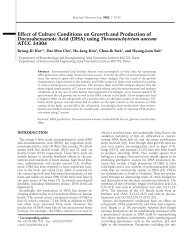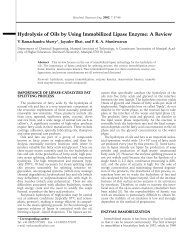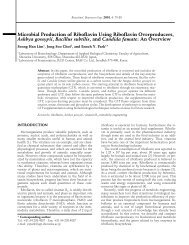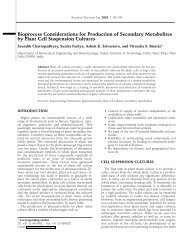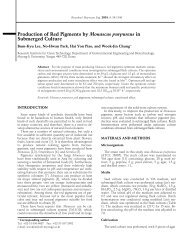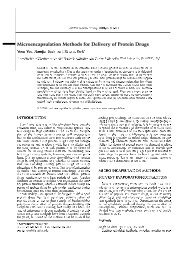Silicone Rubber Membrane Bioreactors for Bacterial Cellulose ...
Silicone Rubber Membrane Bioreactors for Bacterial Cellulose ...
Silicone Rubber Membrane Bioreactors for Bacterial Cellulose ...
Create successful ePaper yourself
Turn your PDF publications into a flip-book with our unique Google optimized e-Paper software.
292 Biotechnol. Bioprocess Eng. 2002, Vol. 7, No. 5(g m -2 day -1 )Fig. 5. <strong>Cellulose</strong> production of A. pasteurianus APSK on siliconerubber membrane of flat sheet, flat sack and cylindrical balloon.on the intact tube surface was not. However superficial celluloseproduction rate was not affected by the processing ofthe tube surface.Electromicrograph of <strong>Cellulose</strong> PelliclesFig. 4. Electromicrograph of bacterial pellicle grown on flat (B)and tubular (A) silicone rubber membranes.ever silicone tube is considerably suitable <strong>for</strong> supplyingoxygen by flowing air through its inner space and easy tohandle. We examined the possibility of using silicone tube<strong>for</strong> static cellulose production further.<strong>Silicone</strong> tube of 3.2 mm outer diameter was used in mostof the experiment. Larger and smaller tubes were used toinvestigate the effect of tube size on cellulose production:outer diameter of 0.8 to 4.0 mm with constant thickness of0.25 mm. The tube size did not affect superficial celluloseproduction rate in the range tested (data not shown).<strong>Bacterial</strong> cellulose pellicle grew radially on a tube surfacethat differed from unidirectional growth on a flat surface.This might be one of the factors deteriorating cellulose productionon a tube surface. More energy is required <strong>for</strong> abacterial pellicle to develop in radial direction because thecellulose fibrils in the pellicle must expand against the firmtensile strength of the circular network of cellulose fibrils.We attached a neoprene rectangular bar (1 mm × 2 mm, 105mm long) or a silicone tube (2 mm od, 1 mm id, 105 mmlong) along the outer surface of the silicone tube (4.0 mmod, 3.5 mm id) to reduce the geometrical restriction againstbacterial growth on a tube surface. The cellulose pelliclegrown on the surface was easily peeled off while thatWe peeled cellulose pellicles from both the surfaces oftubular and flat silicone rubber membranes, and dehydratedthem. Microphotographs of the dry pellicles are shown inFig. 4. With the cellulose pellicle developed on a flat me m-brane cellulose, microfibrils were hardly observed probablydue to close assembly of cellulose microfibrils (Fig. 4(B)).In contrast, the loose networks of cellulose fibrils were observedin the pellicle developed on a tubular surface (Fig.4(A)).<strong>Cellulose</strong> Production on Cylindrical Balloon andFlat Sack of <strong>Silicone</strong> <strong>Rubber</strong> <strong>Membrane</strong>In the previous experiment, we used silicone tubes of 0.8to 4.0 mm in outer diameter to investigate how tube curvatureaffects bacterial cellulose production. There was nosignificant difference in cellulose production rate among thetubes. The rate was much lower than that on a flat me m-brane. To examine whether the tube diameter affects celluloseproduction rate, a silicone rubber cylinder of 30 mm indiameter and 0.15 mm in thickness was used to support thecellulose pellicle in the following experiment. The cylinderwas immersed into a liquid medium after closing the endswith neoprene plugs (Fig. 1(C)). By flowing air through thecylinder at a flow rate of 0.95 dm 3 /min, it inflated like along balloon in the liquid. At a lower air flow rate (0.5dm 3 /min), the balloon deflated and partly wrinkled. We usedanother shape of silicone rubber membrane: a flat siliconerubber sack (Fig. 1(D)) that was made by covering a U-wire with silicone rubber cylinder and closing




